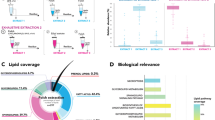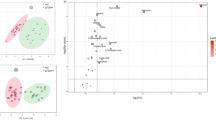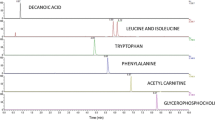Human hepatopathies are a diagnostic challenge, with many distinct diseases having similar clinical signs and laboratory findings. Naturally occurring canine hepatic disease provides an excellent model for human diseases and similar diagnostic dilemmas exist; differentiating canine congenital portosystemic vascular anomalies (PVA) from acquired hepatopathies is difficult and traditionally requires invasive diagnostic procedures. The emerging post-genomic science of metabolomics is concerned with detecting global changes of populations of endogenous low molecular weight metabolites in biological samples and offers the possibility of identifying surrogate profiles of disease. Metabolomics couples sensitive metabolite analysis with sophisticated pattern recognition techniques. In this study, a metabolomic strategy has been employed to assess metabolite changes in the plasma of dogs with congenital PVA and acquired hepatic disease. Plasma samples were collected from 25 dogs, comprising 9 dogs with congenital PVA, 6 with acquired hepatopathy and 10 with non-hepatic disorders. Low molecular weight metabolites were analyzed by liquid chromatography-mass spectrometry (LC-MS). Following identification of metabolites, multivariate data analysis was used to compare profiles amongst groups. The analysis demonstrated significant disturbances in the plasma bile acid and phospholipid profiles of dogs with portovascular anomalies. In contrast to traditional laboratory parameters, the metabolomic strategy was able to produce a clear segregation between all three study groups. In conclusion, this study demonstrates the potential of metabolomics as a diagnostic tool for naturally occurring hepatic disease. With further validation, this approach will improve diagnostic capabilities, provide an insight into pathogenetic mechanisms, and ultimately inform therapeutic decision making in clinical hepatology.






Similar content being viewed by others
References
Allen, J., Davey, H.M., Broadhurst, D., et al. (2003) High-throughput classification of yeast mutants for functional genomics using metabolic footprinting. Nat. Biotechnol. 21, 92–696
Brindle, J.T., Antti, H., Holmes, E., et al. (2002) Rapid and noninvasive diagnosis of the presence and severity of coronary heart disease using 1H-NMR-based metabolomics. Nat. Med. 8, 1439–1444
Center, S.A. (1996) Hepatic vascular diseases in Guilford, W.G., Center, S.A., Strombeck, D.R., Williams, D.A. and Meyer, D.J. (Eds), Strombeck’s Small Animal Gastroenterology, 3rd edn. WB Saunders, Philadelphia, pp. 802–846
Dunn, W.B., Bailey, N.J. and Johnson, H.E. (2005) Measuring the metabolome: current analytical technologies. Analyst 130, 606–625
Fang, N., Yu, S. and Badger, T.M. (2003) LC-MS/MS analysis of lysophospholipids associated with soy protein isolate. J. Agric. Food Chem. 51, 6676–6682
German, J.B., Roberts, M.A. and Watkins, S.M. (2003) Genomics and metabolomics as markers for the interaction of diet and health: lessons from lipids. J. Nutr. 133, 2078S–2083S
Griffin, J.L. (2003) Metabonomics: NMR spectroscopy and pattern recognition analysis of body fluids and tissues for characterisation of xenobiotic toxicity and disease diagnosis. Curr. Opin. Chem. Biol. 7, 648–654
Griffin, J.L. and Shockcor, J.P. (2004) Metabolic profiles of cancer cells. Nat. Rev. Cancer 7, 551–561
Lamers, R.J., DeGroot, J., Spies-Farber, E.J., et al. (2003) Identification of disease- and nutrient-related metabolic fingerprints in osteoarthritic guinea pigs. J. Nutr. 133, 1776–1780
Lehmann, W.D., Koester, M., Erben, G. and Keppler, D. (1997) Characterization and quantification of rat bile phosphatidylcholine by electrospray-tandem mass spectrometry. Anal. Biochem. 246, 102–110
Lenz, E.M., Bright, J., Knight, R., Wilson, I.D. and Major, H. (2004a). A metabonomic investigation of the biochemical effects of mercuric chloride in the rat using (1)H NMR and HPLC-TOF/MS: time dependant changes in the urinary profile of endogenous metabolites as a result of nephrotoxicity. Analyst 129, 535–541
Lenz, E.M., Bright, J., Knight, R., Wilson, I.D. and Major, H. (2004b) Cyclosporin A-induced changes in endogenous metabolites in rat urine: a metabonomic investigation using high field 1H NMR spectroscopy, HPLC-TOF/MS and chemometrics. J. Pharm. Biomed. Anal. 35, 599–608
Lindon, J.C., Nicholson, J.K., Holmes, E., et al. (2003). The role of metabonomics in toxicology and its evaluation by the COMET project. Toxicol. Appl. Pharmacol. 187, 137–146
Mills, K.A., Mustaq, I., Johnson, A.W., Whitfield, P.D. and Clayton, P.T. (1998) A method for the quantitation of conjugated bile acids in dried blood spots using electrospray ionization-tandem mass spectrometry. Pediatr. Res. 43, 361–368
Mustaq, I., Logan, S., Morris, M., et al. (1999) Screening of newborn infants for cholestatic hepatobilary disease with tandem mass spectrometry. Brit. Med. J. 319, 471–477
Nicholson, J.K., Connelly, J., Lindon, J.C. and Holmes, E. (2002). Metabonomics: a platform for studying drug toxicity and gene function. Nat. Rev. Drug Discov. 1, 153–161
Nicholsonm, J.K. and Wilson, I.D. (2003) Understanding ’global’ systems biology: metabonomics and the continuum of metabolism. Nat. Rev. Drug Discov. 2, 668–676
Plumb, R.S., Stumpf, C.L., Granger, J.H., Castro-Perez, J., Haselden, J.N. and Dear, G.J. (2003). Use of liquid chromatography/time-of-flight mass spectrometry and multivariate statistical analysis shows promise for the detection of drug metabolites in biological fluids. Rapid Commun. Mass Spectrom. 17, 2632–2638
Raamsdonk, L.M., Teusink, B., Broadhurst, D., et al. (2000). A functional genomics strategy that uses metabolome data to reveal the phenotype of silent mutations. Nat. Biotechnol. 19, 45–50
Roessner, U., Luedemann, A., Brust, D., et al. (2001) Metabolite profiling allows comprehensive phenotyping of genetically or environmentally modified plant systems. Plant Cell. 13, 11–29
Rosado, B. and Kamath, P.S. (2003). Transjugular intrahepatic portosystemic shunts: an update. Liver Transpl. 9, 207–217
Schafer, K., Ukida, M., Steffen, C., Bode, C., Zelder, O. and Bode, J.C. (1985) Effect of ammonia on plasma and cerebrospinal amino acids in dogs with and without portacaval anastomoses. Res. Exp. Med. 185, 35–44
Wang, Y., Holmes, E., Nicholson, J.K., et al. (2004). Metabonomic investigations in mice infected with Schistosoma mansoni: an approach for biomarker identification. Proc. Natl. Acad. Sci. USA 101, 12676–12681
Watanabe, A. (2000). Portal-systemic encephalopathy in non-cirrhotic patients: classification of clinical types, diagnosis and treatment. J. Gastroenterol. Hepatol. 15, 969–979
Waters, N.J., Holmes, E., Waterfield, C.J., Farrant, R.D. and Nicholson, J.K. (2002). NMR and pattern recognition studies on liver extracts and in livers from rats treated with alpha-naphthylisothiocyanate. Biochem. Pharmacol. 64, 67–77
Wilson, I.D., Plumb, R., Granger, J., Major, H., Williams, R. and Lenz, E.M. (2005). HPLC-MS-based methods for the study of metabonomics. J. Chromatogr. B 817, 67–76
Yang, J., Xu, G., Zheng, et al. (2004). Diagnosis of liver cancer using HPLC-based metabonomics avoiding false-positive result from hepatitisis and hepatocirrhosis diseases. J. Chromatogr. B 813, 59–65
Acknowledgments
We wish to thank the clinicians, support staff and laboratory technicians of the Small Animal Hospital, University of Liverpool for their assistance with the study. Alex German’s lectureship, at the University of Liverpool, is currently funded by Royal Canin.
Author information
Authors and Affiliations
Corresponding author
Additional information
This work was supported in part by grants from The Royal Society, Petplan Charitable Trust and The Waltham Foundation.
Rights and permissions
About this article
Cite this article
Whitfield, P.D., Noble, PJ.M., Major, H. et al. Metabolomics as a diagnostic tool for hepatology: validation in a naturally occurring canine model. Metabolomics 1, 215–225 (2005). https://doi.org/10.1007/s11306-005-0001-3
Received:
Accepted:
Published:
Issue Date:
DOI: https://doi.org/10.1007/s11306-005-0001-3




